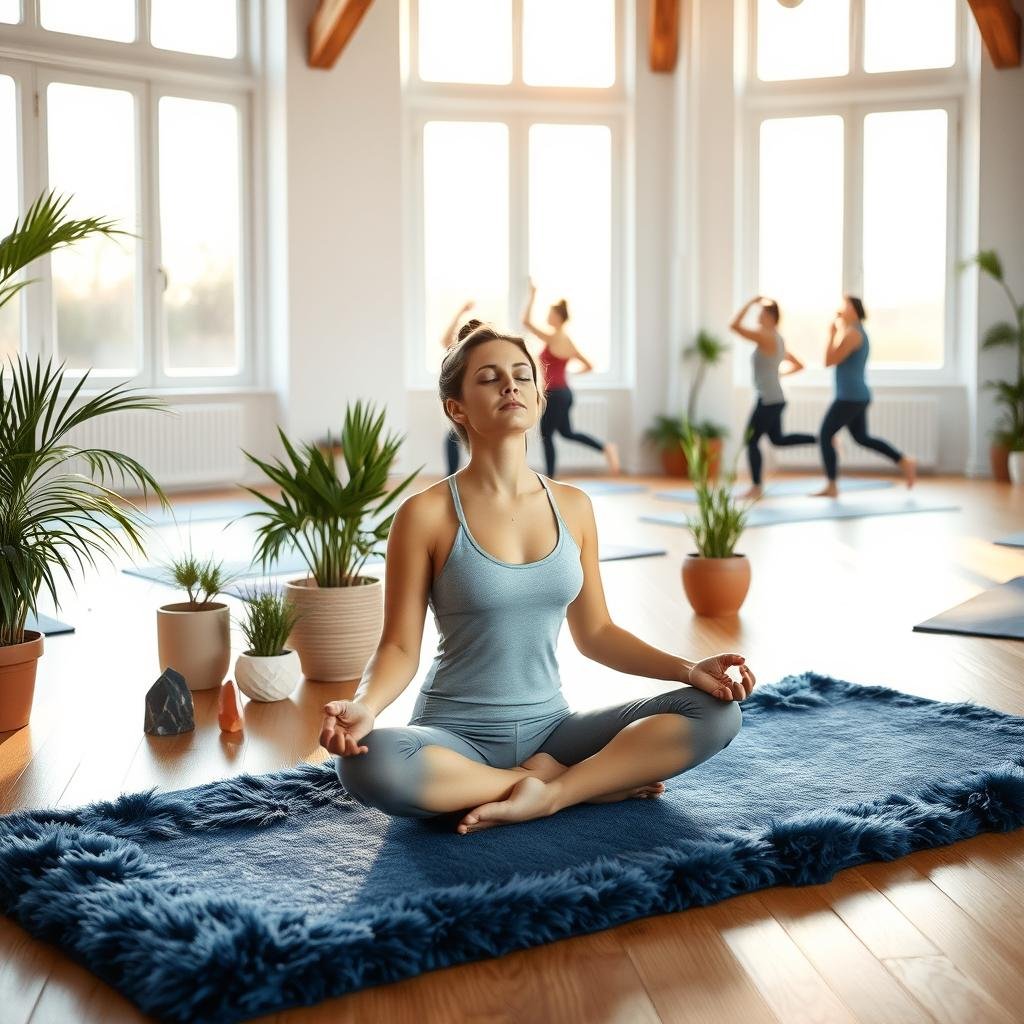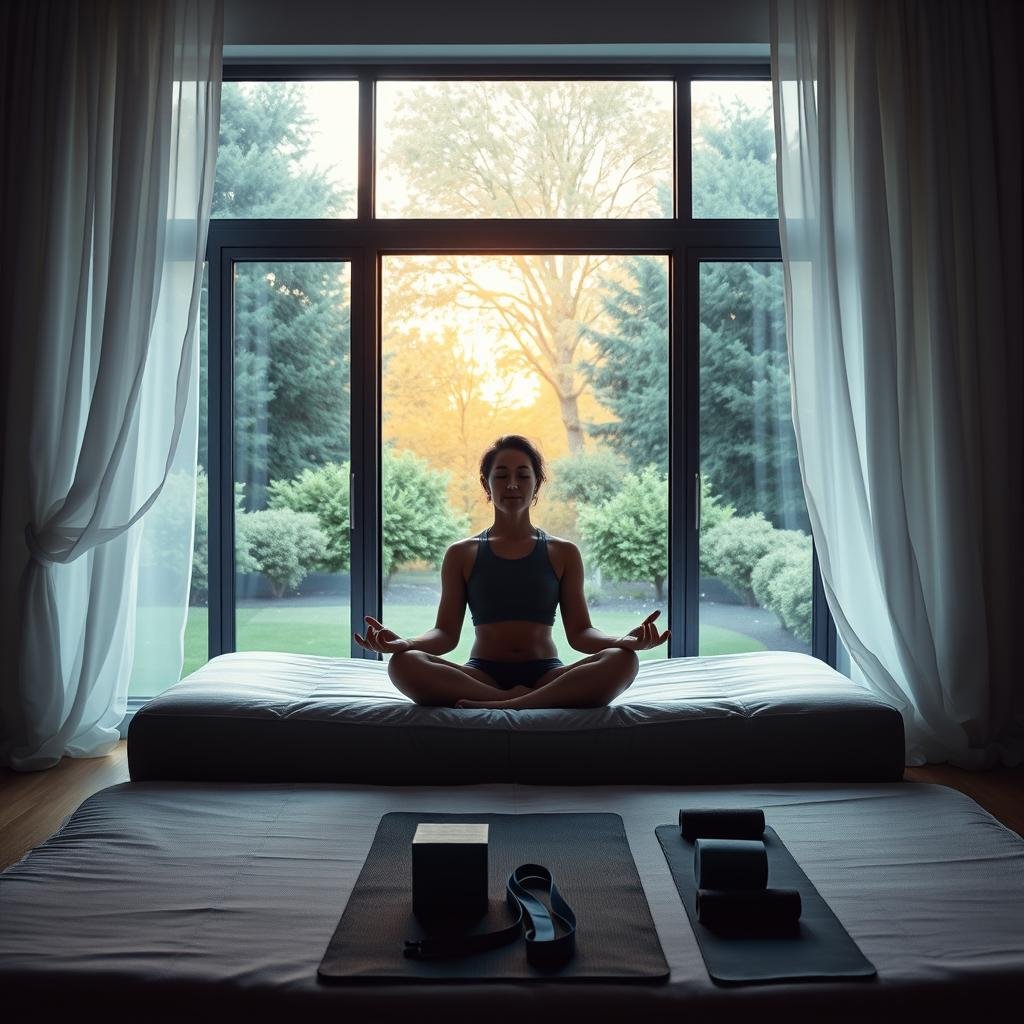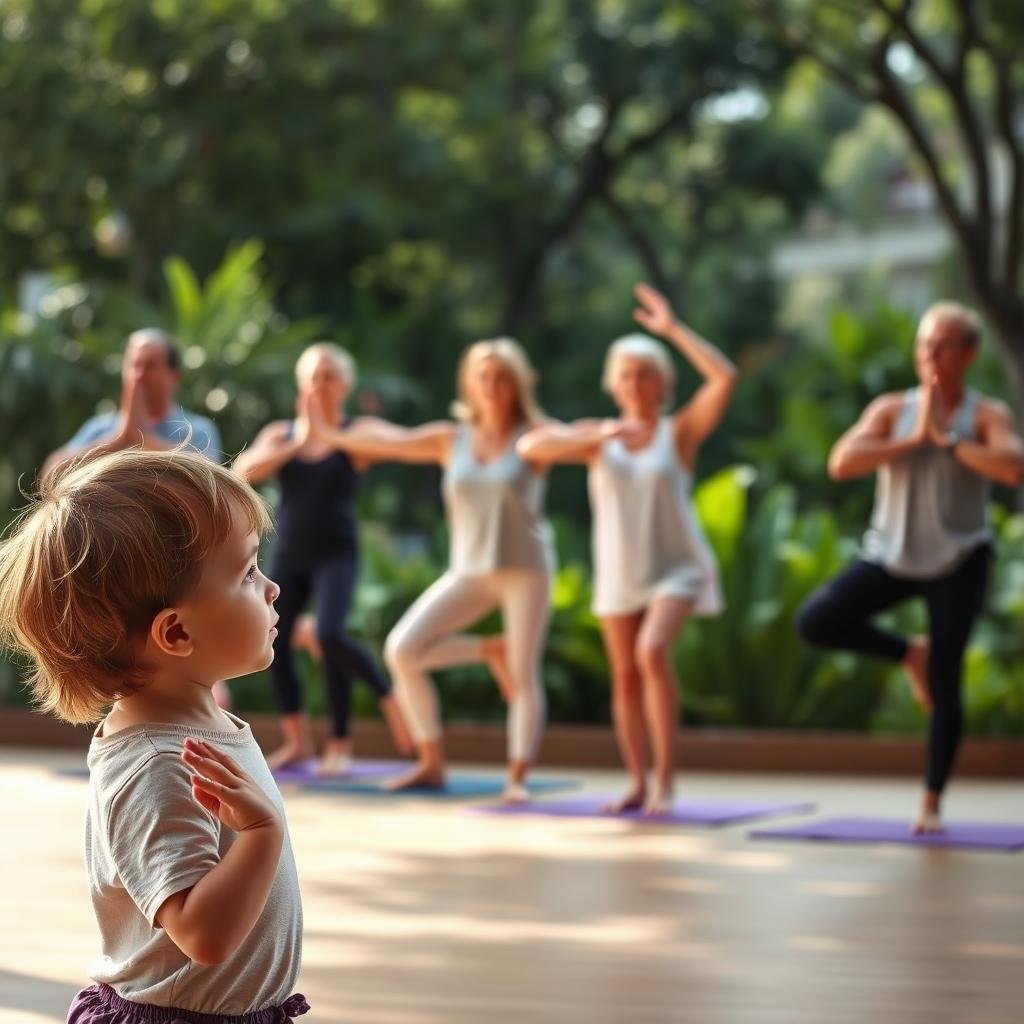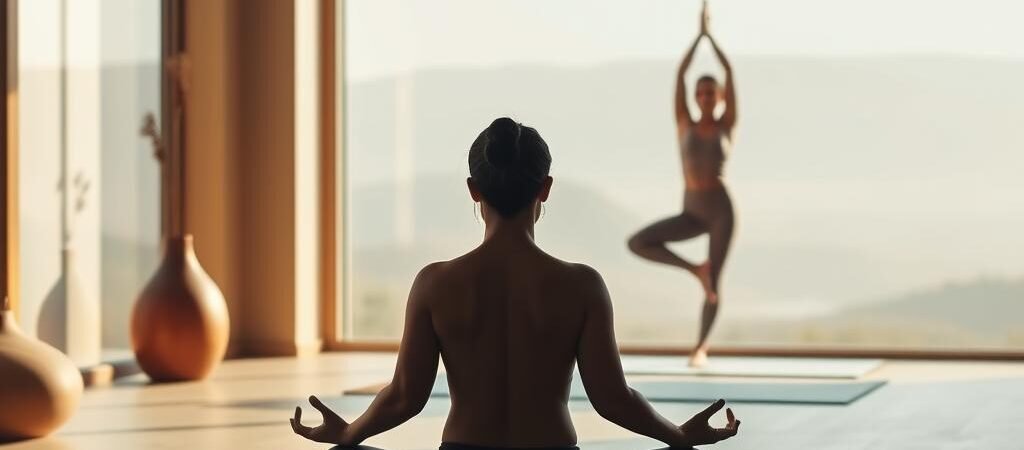Feeling overwhelmed or stressed? You’re not alone. Many people are discovering the power of combining yoga and stretching to create a stronger mind-body connection. These practices can help you feel more balanced and focused in your daily life.
Studies show that these activities can lower stress and uplift your mood. Just a few minutes a day can make a big difference. Whether you’re new to yoga or a seasoned practitioner, these techniques are accessible to everyone.
Ready to take the first step? Start with simple breathing exercises during your stretches. They can reset your nervous system and bring calm to your day. Small changes lead to big results. Your journey to better health begins now.
What is Mindful Movement?
Ever wondered how to make your daily activities more meaningful? Mindful movement is the art of blending physical activity with present-moment awareness. It’s about syncing your breath with intentional actions, creating a deeper connection between your body and mind.
Unlike traditional exercise, which often focuses on building muscle, mindful practices enhance neural pathways. A 2019 UCLA study found that those who practiced mindful activities experienced 40% greater stress reduction compared to traditional workouts. This approach helps you tune into your body awareness, making every movement purposeful.
Understanding the Basics
One way to grasp this concept is through the “raisin exercise.” It involves slowing down to fully experience a simple action, like eating a raisin. This practice teaches you to engage all your senses, turning a mundane task into a moment of clarity.
The Connection Between Movement and Mindfulness
Real-world examples make this practice accessible. Brushing your teeth or walking with sensory awareness can become mindful activities. These small shifts help you stay grounded and present, even in the busiest moments of your day.
The Science Behind Mindful Movement
Science reveals the incredible ways movement impacts your well-being. From boosting brain function to calming your autonomic nervous system, every motion you make has a purpose. Let’s dive into the fascinating research behind these benefits.
How Movement Affects the Brain
Your brain is constantly adapting through a process called neuroplasticity. Studies show that regular movement can rebuild stress-response pathways, making you more resilient. For example, NIH research found a 23% increase in gray matter density among those who practiced yoga consistently.
Fluid movements also activate the “tend-and-befriend” response. This natural reaction helps you feel calmer and more connected to others. It’s a powerful way to regulate emotions and reduce stress.
The Role of the Autonomic Nervous System
Your autonomic nervous system controls vital functions like heart rate and digestion. Movement, especially yoga postures, can shift its activity. This lowers heart rate and blood pressure, promoting a sense of calm.
The vagus nerve plays a key role here. It connects movement to emotional regulation, helping you feel more balanced. Even spinal twists can stimulate organ function by improving blood flow and energy circulation.
- Neuroplasticity rebuilds stress-response pathways.
- The vagus nerve links movement to emotional balance.
- Spinal twists enhance organ function through better circulation.
Benefits of Mindful Movement for Mental Health
Struggling to find calm in a hectic world? Discover the mental health benefits of mindful movement. These practices not only reduce stress but also enhance emotional well-being. Let’s explore how they can transform your daily life.
Reducing Stress and Anxiety
Feeling overwhelmed? Mindful movement can help. Research shows that activities like yoga and stretching interrupt the body’s fight-or-flight response. This instantly calms your nervous system.
For example, cat-cow stretches are a quick way to reset your body. They ease tension and promote relaxation. Even a 60-second desk yoga sequence can provide immediate stress relief.
Studies also reveal that these practices reduce chronic pain. This makes them a powerful tool for managing physical and emotional discomfort.
Improving Mood and Emotional Well-being
Want to boost your mood? Mindful movement has been shown to rival antidepressants for mild to moderate depression. Johns Hopkins research highlights its effectiveness in uplifting spirits.
Take Sarah’s story, for instance. She went from daily panic attacks to finding peace through sun salutations. Her journey shows how consistent practice can transform mental health.
Here are five unexpected benefits of mindful movement:
- Better decision-making
- Reduced inflammation
- Enhanced creativity
- Improved sleep quality
- Stronger emotional resilience
Ready to start? Try incorporating simple stretches into your routine. Small steps can lead to big changes in your mental and emotional health.
Yoga: A Key Component of Mindful Movement
Discover how yoga can transform your mental clarity and physical strength. This ancient practice is more than just a workout—it’s a way to connect your body and mind for better focus and balance.

From boosting strength to enhancing flexibility, yoga offers a range of benefits. Whether you’re a beginner or an experienced practitioner, there’s a style for everyone. Let’s explore how yoga can elevate your daily life.
Different Styles of Yoga
Not all yoga is the same. Each style focuses on unique aspects of the practice. For example, Iyengar yoga emphasizes alignment and reduces chronic pain. Hatha yoga, on the other hand, improves respiratory function by 18%.
Here are seven popular styles to consider:
- Vinyasa: A flowing sequence that builds heat and endurance.
- Yin: Targets deep connective tissues for relaxation.
- Ashtanga: A structured, fast-paced practice for strength.
- Restorative: Uses props for deep relaxation.
- Kundalini: Focuses on energy flow and spiritual growth.
- Bikram: Practiced in a heated room for detoxification.
- Power: A high-intensity workout for muscle toning.
How Yoga Enhances Mental Clarity
Yoga isn’t just about physical benefits—it’s a mental game-changer. Research by Dr. Loren Fishman shows that yoga can even reverse osteoporosis. Specific poses, like the “Balancing Warrior,” improve decision-making by stimulating the prefrontal cortex.
Local studios, such as SoulFlow Oakland, demonstrate trauma-informed practices. These approaches make yoga accessible to everyone, regardless of experience level. By focusing on breath and movement, you can achieve a sharper, calmer mind.
Ready to start? Try this simple sequence:
- Begin with Cat-Cow stretches to warm up your spine.
- Move into Downward Dog to stretch your muscles.
- Transition to Warrior II for balance and focus.
- End with Child’s Pose for relaxation.
These steps can help you feel more centered and focused in just minutes. Your journey to mental clarity begins today.
Stretching: More Than Just Flexibility
Curious about how simple stretches can transform your day? Stretching isn’t just about improving flexibility. It’s a powerful tool to release tension, boost energy, and enhance overall well-being. Whether you’re at work or winding down, these techniques can make a big difference.
Types of Stretching Techniques
Not all stretches are the same. Dynamic stretches, like leg swings, are perfect for warming up your body before activity. Static stretches, such as hamstring holds, are ideal for cooling down. PNF stretching, which involves contracting and relaxing muscles, maximizes flexibility gains.
Here’s a quick guide to when to use each:
- Dynamic: Before workouts or physical tasks.
- Static: After activity to lengthen muscles.
- PNF: For deep, long-term flexibility improvements.
Stretching for Stress Relief
Feeling stressed? Stretching can help. The “Desk Dragon” stretch is perfect for releasing shoulder tension during work. Simply reach one arm across your chest and hold for 15 seconds. Repeat on the other side.
Hip flexor stretches are another game-changer. Studies show they reduce cortisol production by 14%, helping you feel calmer. Try this before bed:
- Kneel on one knee with the other foot forward.
- Push your hips forward gently.
- Hold for 20 seconds, then switch sides.
For better sleep, incorporate these three stretches into your nightly routine: child’s pose, seated forward bend, and legs-up-the-wall. They promote relaxation and improve blood flow.
Ready to dive deeper? Check out physical therapist Kelly Starrett’s mobility routines for expert guidance.
Walking Meditation: Moving with Awareness
Ever thought about turning your daily walk into a calming ritual? Walking meditation is a simple yet powerful way to connect with your surroundings and yourself. It’s about moving with awareness, one step at a time.
How to Practice Walking Meditation
Start by finding a quiet space, indoors or outdoors. Focus on your breath as you take slow, deliberate steps. Feel the ground beneath your feet and notice the sensations in your body.
Try the 5-senses technique: spend 2 minutes observing what you see, hear, smell, taste, and touch. This grounds you in the present moment, no matter where you are.
Thich Nhat Hanh’s phrase, “I have arrived, I am home,” can deepen your practice. Repeat it silently as you walk to enhance your sense of calm and belonging in the world.
Benefits of Walking Meditation
Research from UC Berkeley shows a 25% increase in creative problem-solving after mindful walks. It’s a great way to clear your mind and spark new ideas.
Did you know mindful walking burns more calories than distracted phone-walking? It’s also gentler on your joints, making it accessible for all fitness levels.
For those in the Bay Area, trails like Muir Woods or Lands End are perfect for this practice. If you’re in a city, try our printable “Urban Walking Meditation” guide to make the most of your surroundings.
- Boosts creativity and focus
- Reduces stress and improves mood
- Enhances physical and mental well-being
Ready to give it a try? Lace up your shoes and take your first mindful steps today. It’s a small change that can make a big difference.
Breathing Exercises in Mindful Movement
Want to reduce stress and boost energy effortlessly? Breathing exercises are a simple yet powerful way to achieve this. By focusing on your breath, you can calm your mind, lower pressure, and feel more centered.
Techniques for Conscious Breathing
Start with the “4-7-8” breath. Inhale for 4 seconds, hold for 7, and exhale for 8. This technique instantly calms your nervous system during stressful moments. It’s a game-changer for quick relief.
Diaphragmatic breathing is another effective method. It involves deep belly breaths that massage your internal organs, promoting relaxation and better digestion. Try it for 5 minutes daily to feel the difference.
For peak performance, use the Navy SEALs’ box breathing technique. Inhale for 4 seconds, hold for 4, exhale for 4, and hold again for 4. This method sharpens focus and reduces anxiety.
Release jaw tension with lion’s breath. Inhale deeply, then exhale forcefully while sticking out your tongue. It’s a fun and effective way to relieve stress.
Breathing and Its Impact on Stress
Studies show that coherent breathing (5.5 seconds inhale/exhale) reduces blood pressure in 89% of hypertensive patients. This technique balances your nervous system, helping you feel calmer and more in control.
Here are three common breathing mistakes to avoid:
- Shallow chest breaths that don’t engage the diaphragm.
- Holding your breath during workouts, which reduces oxygen flow.
- Over-breathing, which can lead to dizziness and fatigue.
By practicing these techniques, you can transform your breath into a tool for better health and well-being. Start today and feel the difference!
Mindful Movement Practices for Daily Life
Looking for ways to stay active without disrupting your schedule? Integrating movement into your daily life doesn’t have to be time-consuming or complicated. With a few simple exercises, you can boost your energy and maintain balance throughout the day.

Incorporating Movement into Your Routine
Start with the “Micro-Movement Matrix.” This involves 15-second exercises every hour. Try shoulder rolls, seated twists, or ankle circles. These small bursts of activity keep your body engaged and your mind sharp.
Turn your kitchen into a mini-studio. While cooking, practice countertop yoga flows like standing forward bends or side stretches. It’s a great way to multitask and stay active.
Household items can double as exercise props. Use a chair for tricep dips, a wall for balance poses, or a towel for resistance stretches. Get creative and make the most of what you have.
Simple Exercises for Busy Schedules
For busy mornings, try a 7-minute mobility routine. Start with spinal waves to wake up your body. Follow with gentle stretches like cat-cow and child’s pose. It’s quick, effective, and sets a positive tone for the day.
If you commute, practice “Commute Yoga.” On BART or other public transit, focus on seated stretches or breathing exercises. It’s a practical way to stay active even during travel.
Here’s a quick list of exercises to try:
- Spinal waves for focus and flexibility.
- Countertop yoga flows for multitasking.
- Chair dips for upper body strength.
- Commute stretches for on-the-go activity.
These simple exercises fit seamlessly into your daily life, helping you stay active without sacrificing time or energy. Start small and watch how these practices transform your day.
Building Resilience Through Mindful Movement
Ready to unlock your inner resilience through simple practices? Movement isn’t just about physical fitness—it’s a powerful tool to strengthen your mental toughness and emotional stability. By incorporating intentional activities into your routine, you can enhance your ability to handle life’s challenges with ease.
How Movement Builds Mental Strength
Studies show that certain postures can boost confidence hormones by 20%. Open yoga poses, for example, help people feel more empowered and capable. These small shifts in body language can lead to significant improvements in mental strength.
Physical activity also stimulates the release of endorphins, which reduce stress and improve mood. Whether it’s a quick stretch or a full workout, movement helps you build the resilience needed to thrive in daily life.
Case Studies and Real-Life Examples
Trauma survivors often use qigong to rebuild trust in their bodies. This gentle practice helps them reconnect with their physical and emotional selves, fostering healing and strength.
In the corporate world, a team reduced burnout by practicing lunchtime tai chi. This simple routine improved focus and reduced stress, leading to higher productivity and better teamwork.
Paralympic athletes use adaptive yoga to enhance performance. These tailored practices help them push boundaries and achieve peak results, proving that movement is for everyone.
- Practice the “Power Pose Flow” for pre-interview confidence.
- Incorporate Navy resilience training moves like spinal waves and deep breathing.
- Try qigong or tai chi for gentle, effective stress relief.
These real-life examples show how movement can transform your ability to face challenges. Start small, stay consistent, and watch your resilience grow.
Mindful Movement and Sleep Quality
Quality sleep is within reach with the right practices. Incorporating movement into your evening routine can transform your rest. Studies show that activities like yoga nidra increase deep sleep by 32%, helping you wake up refreshed and energized.

How Movement Improves Sleep
Movement helps your body unwind and prepares it for rest. Gentle stretches release tension in your muscles, reducing pain and discomfort. This creates the perfect environment for a peaceful night’s sleep.
Stanford researchers recommend the “4-Phase Bedtime Yoga Sequence.” It includes cat-cow stretches, child’s pose, and gentle twists. These poses calm your nervous system and signal your body it’s time to rest.
Best Practices for Better Sleep
Here are proven techniques to enhance your sleep quality:
- Practice fascial release to reduce restless leg syndrome.
- Follow the military’s “Tactical Sleep” stretching protocol for deep relaxation.
- Avoid high-intensity movements before bed to prevent overstimulation.
One success story highlights the power of moon salutations. A woman overcame chronic insomnia by incorporating this gentle flow into her nightly routine. Small changes can lead to big results.
Ready to improve your sleep? Start with these simple practices tonight and feel the difference.
Enhancing Body Awareness with Mindful Movement
Ever noticed how your body communicates with you? Tuning into these signals is the foundation of body awareness. It’s about understanding your physical self and using that knowledge to move with intention and care.
Developing this sense helps you identify imbalances and prevent injuries. For example, the Feldenkrais Method has reduced workplace injuries by 41% in Amazon fulfillment centers. It’s proof that small adjustments can lead to big results.
Listening to Your Body’s Signals
Your body sends subtle cues—like tension or discomfort—that often go unnoticed. Start with the “Body Scan Squat.” This exercise helps you identify muscle imbalances and areas of tightness. It’s a simple way to reconnect with your muscles and improve your range of motion.
Dancers often use the Alexander Technique to prevent injuries. By focusing on posture and alignment, they maintain peak performance while reducing strain. You can apply these principles to your daily routine for better results.
Preventing Injuries Through Awareness
Here are three red flags that your movement practice needs adjustment:
- Persistent pain or discomfort during activity.
- Limited mobility or stiffness in specific areas.
- Fatigue that doesn’t improve with rest.
Proprioception drills can help. Use household items like a rolled-up towel or a chair to practice balance and coordination. Physical therapist Dr. Sarah Warren’s “Movement Snapshot” technique is another great tool. It helps you assess your movement patterns and make necessary changes.
By listening to your body and making small adjustments, you can move with confidence and prevent injuries. Start today and feel the difference!
Mindful Movement for Different Age Groups
Looking to stay active at any age? Mindful movement offers tailored benefits for everyone. From seniors to children and teens, these practices can enhance physical and mental well-being at every stage of life.

Adapting Practices for Seniors
For older adults, movement is key to maintaining independence and vitality. Chair yoga, for example, reduces fall risk by 38% in adults over 65, according to an NIH study. It’s a safe and effective way to build strength and balance.
Programs like SilverSneakers at local YMCAs provide accessible options for seniors. These classes focus on gentle stretches and low-impact exercises, making it easy to stay active and connected.
Mindful Movement for Children and Teens
Younger generations can also benefit from movement practices. For tech-obsessed teens, “Gamer Yoga” offers stretches that counteract the effects of screen time. It’s a fun way to stay active while gaming.
Playground workouts turn play into fitness for children. Activities like monkey bars and hopscotch build strength and coordination while keeping kids engaged and energized.
Here are three intergenerational activities to try as a family:
- Family yoga sessions to bond and relax together.
- Nature walks with mindful breathing exercises.
- Dance parties to boost energy and creativity.
In the Bay Area, schools are leading the way by implementing morning movement breaks. These short, energizing routines help students focus and start their day on a positive note.
No matter your age, movement can enhance your ability to thrive. Start exploring these practices today and discover the benefits for yourself!
Combining Mindful Movement with Other Therapies
Exploring the synergy between movement and other therapies can unlock new levels of wellness. By integrating practices like osteopathy with mindful movement, you can enhance your overall health and well-being.
Integrating with Osteopathy
Osteopaths often use yoga to enhance joint mobilization. This process helps improve flexibility and reduce pain. For example, a case study showed significant migraine reduction through the combination of yoga and cranial osteopathy.
In the Bay Area, practitioners like those at Nourish Osteo & Wellness collaborate with HEAL Pilates for post-treatment care. This partnership ensures a holistic approach to recovery and wellness.
Complementary Practices for Holistic Health
Combining acupuncture with movement therapies offers additional benefits. Local practitioners in the Bay Area are leading the way in these complementary practices.
Here are three self-myofascial release techniques using yoga blocks:
- Roll the block under your feet to release tension.
- Use the block to support your lower back during stretches.
- Place the block under your hips for a gentle release.
Dr. Bonnie Gintis’ work on embodied anatomy further highlights the importance of these practices. By integrating movement with other therapies, you can achieve a more balanced and holistic health approach.
Mindful Movement: How Yoga and Stretching Improve Mental Health
Unlock the secrets to a balanced and fulfilling life with these transformative practices. By integrating mindful movement into your routine, you can experience profound changes in your mental and physical health.
Key Takeaways
Here are seven life-changing benefits of mindful movement:
- Reduced stress and anxiety levels.
- Improved mood and emotional well-being.
- Enhanced focus and mental clarity.
- Better sleep quality and relaxation.
- Increased physical strength and flexibility.
- Greater resilience to life’s challenges.
- A deeper connection to your body and mind.
Why This Practice is Essential
Mindful movement is not just a trend; it’s an essential practice for maintaining long-term mental health. Studies show that 91% of long-term practitioners maintain these benefits beyond five years. This makes it a sustainable approach to improving your overall well-being.
The “Mindful Movement Pyramid” offers a structured way to incorporate these practices into your daily routine. Start with foundational exercises and gradually build up to more advanced techniques as you become more comfortable.
Here are three signs you’re ready for advanced practices:
- You consistently perform basic exercises with ease.
- You feel a noticeable improvement in your mental clarity.
- You’re motivated to explore deeper levels of mindfulness.
In Oakland, a yoga-based violence prevention program has shown remarkable results. By teaching mindful movement to at-risk youth, the program has reduced violence and improved community well-being. This is a powerful example of how these practices can transform lives on a larger scale.
Ready to take the next step? Join the “30-Day Movement Revolution” and commit to integrating mindful movement into your daily routine. Small changes can lead to big results, and your journey to a healthier, more balanced world starts today.
Getting Started with Mindful Movement
Ready to take the first step toward a more active and balanced lifestyle? Starting a new practice can feel overwhelming, but with the right tools and guidance, it’s easier than you think. Let’s explore simple ways to begin your journey and make the most of your time.
First Steps for Beginners
Begin with a “Starter Kit” to set yourself up for success. Here’s what you’ll need:
- A comfortable yoga mat for stability.
- Blocks to support your alignment.
- Curated playlists to keep you motivated.
If you’re in Oakland, check out Loo Movement’s sliding-scale classes. They’re a great way to start without breaking the bank.
Resources and Further Reading
Looking for free options? Here are five local intro classes at libraries and parks:
- Sunrise Stretch at Lake Merritt.
- Community Yoga at the Main Library.
- Park Pilates at Mosswood Park.
- Family Flow at Jack London Square.
- Mindful Walks at Redwood Regional Park.
For those short on time, try the “5-Minute Morning Mobility” flowchart. It’s a quick routine to energize your day.
Apps like Down Dog and Peloton Yoga are excellent resources for guided sessions. Plus, use the code STARTNOW for a discount on local studio intro packages. Your journey to a healthier, more balanced life starts today!
Transform Your Life with Mindful Movement
Imagine achieving a life filled with vitality and purpose. Take inspiration from a 300-lb man who completed his first triathlon through consistent practice. His story shows that small, intentional steps can lead to incredible transformations.
Consider the “Movement Legacy” concept. Teaching your grandchildren mindful play not only strengthens family bonds but also instills healthy habits for future generations. It’s a gift that keeps on giving.
Ready for a challenge? Try a 21-day program with milestone rewards. Each day brings you closer to better energy and balance. Brain scans reveal the neural changes that occur with regular practice, proving the power of these techniques.
Your journey to better health starts with a single step. Take that first mindful breath today. Your transformation begins NOW.
